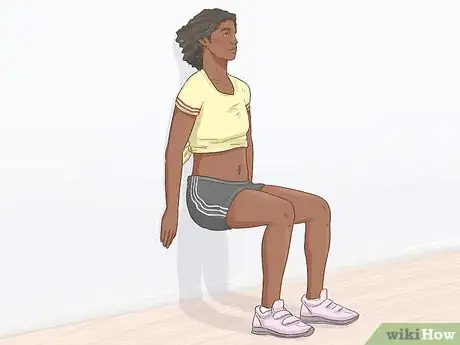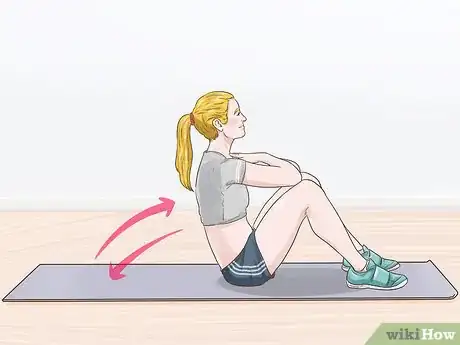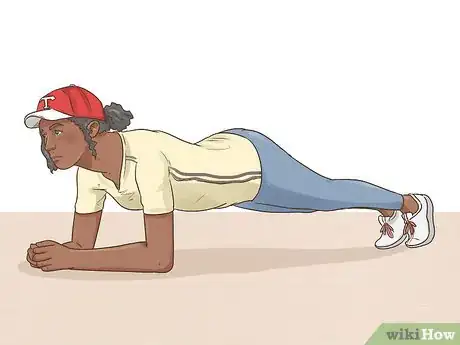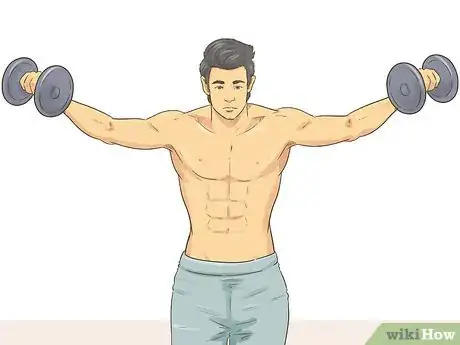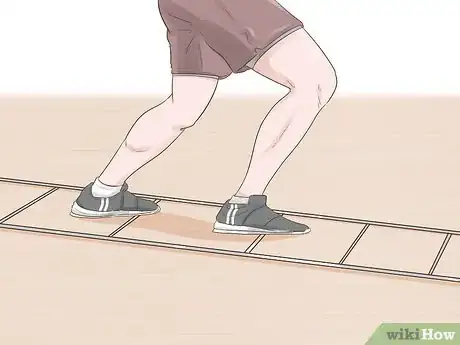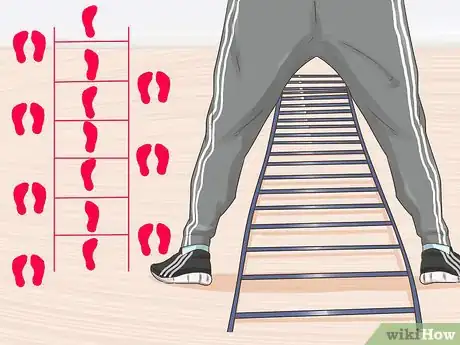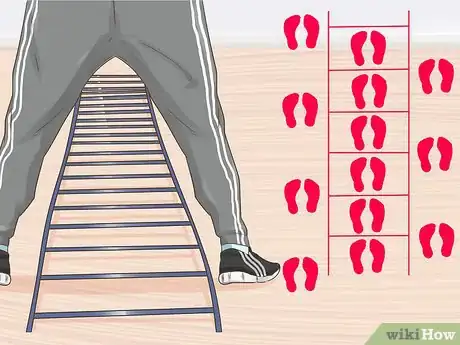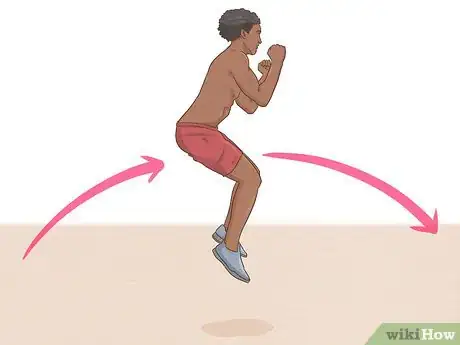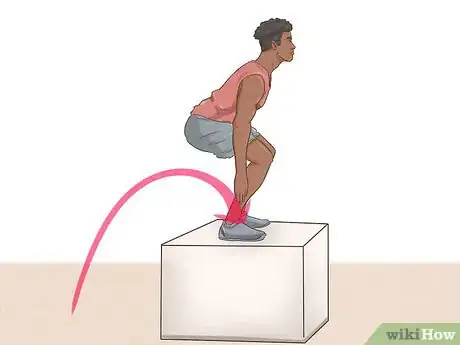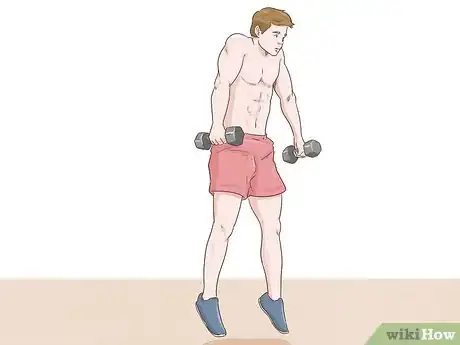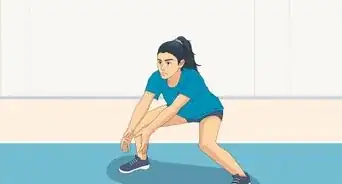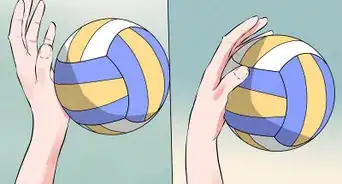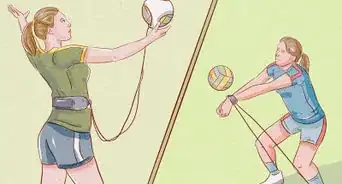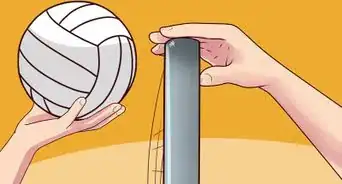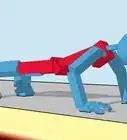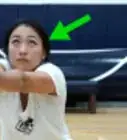This article was co-authored by wikiHow Staff. Our trained team of editors and researchers validate articles for accuracy and comprehensiveness. wikiHow's Content Management Team carefully monitors the work from our editorial staff to ensure that each article is backed by trusted research and meets our high quality standards.
There are 8 references cited in this article, which can be found at the bottom of the page.
wikiHow marks an article as reader-approved once it receives enough positive feedback. In this case, 92% of readers who voted found the article helpful, earning it our reader-approved status.
This article has been viewed 82,589 times.
Learn more...
Before you even pick up a ball or hit the court, it is important to condition your body to the physical demands of volleyball. Having a strong core, arms, and legs are key to being a successful player. But volleyball is one of those sports where you may be standing more or less at rest for long periods, and then suddenly need to explode into action. While exercises like running or biking can also build key muscles, they are little help in preparing you for this. Instead, focus on exercises that test your agility and your ability to explode into the air from standing at rest.
Steps
Strengthening Your Legs
-
1Perform lunges.[1] Start from a standing position. First, straighten your back and roll your shoulders back and down to keep your core engaged. Raise your chin and fix your eyes at a spot directly in front of you, at eye-level. Then:
- Take a step forward with one leg so that ankle is directly below your knee, with your calf and upper thigh forming a right angle.
- At the same time, let your hips sink to the floor, so that your other leg also forms a right angle as its knee nears the floor.
- Support your weight with your forward heel as you use that leg to push yourself back into a standing position.
- Repeat with your other leg for one rep.
- Start small if you need to, adding sets and reps as you build strength, until you are able to do three sets of 20 reps.
- For an extra challenge, hold weights at your side for added resistance.
-
2Execute wall sits.[2] Place your feet about two feet away from the wall (a little over half a meter). Let your upper back rest against the wall. This is your starting position. From there:
- Let your hips sink until each leg's calf and thigh form a right angle.
- Make sure that the back of your head, shoulders, and your whole upper back stay flush against the wall.
- Divide your weight evenly between both feet and keep them flat on the floor, from toe to heel.
- Hold that position for 30 seconds before pushing with your legs back into a standing position.
- Do three sets of one rep each, working your way up to 45 seconds in your second rep and a whole minute in your third.
Advertisement -
3Do jumping jacks.[3] Stand up straight, placing your feet side by side so your insteps are touching. Let your arms hang down along your sides, with your palms flat against the outside of your thighs. From this starting position:
- Jump into the air, spreading your feet apart and raising your legs to either side.
- At the same time, raise your arms to either side and over your head.
- As you come back down, lower your feet and arms back into starting position for one rep.
- Aim to complete three sets of 50 jumping jacks each workout, starting with fewer or smaller sets if needed until you work up to that.
Building Up Your Upper Body
-
1Strengthen your core with sit-ups.[4] Lie down on the floor with your whole upper back on the ground. Keeping both feet flat on the floor, draw them in toward your butt so that your knees bend, with your legs resembling a raised tent. Touch the backs of your ears with your fingertips while drawing your shoulder blades together, so that your elbows point outward from your sides instead of ahead. From here:
- Engage your abs to pull your upper body off the floor and toward your knees.
- Be careful not to yank yourself forward with your head or shoulders.
- Once your upper body meets or nears your thighs, use your abs to lower your upper body back down to the ground for one rep.
- Increase the number of reps and/or sets with the goal of reaching three sets of 50 per workout.
-
2Use planks to build your core, arms, and back. First, get into a position for a push-up, with your toes lifting your lower body into the air. But instead of placing your hands on the floor, use your elbows instead. Set them directly below your shoulders with your forearms flat on the floor, pointed ahead of you, so both arms form right angles. Once you are in position:[5]
- Draw your belly button inward, toward your spine, to straighten your back and get those core muscles active.
- Let your forearms support your upper body and raise your palms off the floor if necessary to make sure of this.
- Aim to hold this position for half a minute as your first set.
- Repeat with two more sets, adding time to each until your second set is 45 seconds and your third set is 60.
-
3Work out with lateral dumbbell raises. First, choose a weight that is light enough for you to control each lift from beginning to end in order to avoid injury. In the beginning, start with something light, such as five to ten pounds each, to avoid straining yourself. Then stand with your feet about hip-width apart. With a dumbbell in each hand, hold them at your sides, keeping your arms straight and your palms facing in toward the outside of your thighs. From this starting position:[6]
- Bend your elbows a bit and begin your lift, raising the dumbbells outward to either side of you.
- As you do, angle each dumbbell so that the forward weight dips down, as though you were emptying a glass.
- Continue your lift until your arms are spread out to either side of you, parallel to the floor.
- At this point, hold your position for a second after your last exhale.
- Now inhale and bring your arms slowly back down to your sides to finish your rep.
- Condition yourself toward the goal of completing three sets of 25 lifts each for each workout.
Developing Agility
-
1Do ladder drills. Grab a piece of chalk and draw a ladder with four rungs (or multiples of four: 8, 12, 16, 20, etc). Make sure there is enough space between each rung to fit both feet. Even though real ladders usually don’t have them, draw two more rungs along the very top and very bottom. From the bottom up, mark the space between each rung from 1 to 4 (and onward, depending on how long your ladder is).[7] Use this ladder to practice drills that will increase your agility, speed, and coordination.[8] When doing ladders:
- Use the balls of your feet to push yourself up and off the ground when you jump.
- Bend your elbows to form right angles with your arms and pump those arms with each jump or step, as if you were running.
- Relax your upper body while keeping your head immobile as best you can.
- Start slow to master each pattern, then increase your speed once you can do each one smoothly.
- Start each set with your left foot as your lead foot, then alternate feet with your next set so that both grow comfortable with leading.
-
2Start with hop-scotch drills. Try this easy pattern to ease into the practice. Place both feet hip-width apart with your toes just an inch or two away from the bottom rung. Now push off the ground with the balls of both feet and land on your left foot only inside Space #1. From there:[9]
- Jump from your left foot as soon as you land.
- Land with both feet in Space #2 and then use both to jump again right away.
- Land with your right foot only in Space #3 and use that foot only to jump again.
- Land with both feet in Space #4.
- Repeat until you complete the whole ladder.
-
3Move on to in-out drills. Improve your range of motion by landing to either side of the ladder, as well as inside. With this drill, however, simply step from mark to mark, rather than jump. To begin, assume the starting position at the base of the ladder. Then:
- Step into Space #1 with your left foot, then your right foot.
- Leading with your left foot, step to the outside of Space #2, followed by your right foot on the opposite side, so you straddle the ladder.
- Step inside Space #3 with your left foot and then your right.
- Leading with your left foot, step to the outside of Space #4, with your right foot doing the same to straddle the ladder again.
- Continue this pattern until you reach the end of the ladder.
-
4Up the stakes with the lateral feet drill. Improve your side-to-side motion. As you step in and out of each space, use a one-two count (“One, two … one, two …”) for your feet’s movements to avoid tripping yourself up. With this drill, start with both feet below and to the left of the bottom rung. Now:[10]
- Step into Space #1 with your left foot (“One”), then your right (“Two”).
- From there, cross your left leg in front of your right and place your left foot outside and to the right of Space #1 (“One”).
- Now bring your right foot outside of Space #1 and plant it to the right of your left foot (“Two”).
- From there, step into Space #2 with your left foot first (“One”), then your right (“Two”).
- With your left foot, move directly to your left and step outside of Space #2 with your left foot, then your right (“Two”).
- Keep this pattern up until you complete the ladder.
- With your next set, switch sides at the beginning. Start from the right of the ladder and lead with your right foot.
Working on Your Jump
-
1Do frog jumps.[11] Place your feet slightly more than hip-width apart. Wrap your fingers behind your head with your elbows sticking out to either side. Sink into a squat until your legs form a roughly 90- degree angle. Keep your upper body as vertical as possible and your chin up so that you are looking forward, not down. From here:[12]
- Use the balls of your feet to push yourself up and forward into a jump.[13]
- Don’t worry about jumping high. Simply aim to land a few feet in front of your starting position.
- As you land on the balls of your feet, absorb the shock with your legs by sinking back into another squat.
- Jump again and repeat for a total of five to ten reps per set.
-
2Use a “jump box.” Use an actual jump box that is specifically designed for jumping exercises (which many gyms provide), or use any raised surface that will support your weight, like a sturdy, steady bench or bleachers. Stand within jumping distance with both feet planted hip-width apart, facing the box. From this starting position:[14]
- Jump off the ground with both feet, using the balls of your feet to push yourself off the ground.[15]
- Land on the box with both feet, distributing your weight evenly across them to stay balanced.
- Starting small so you have as much control over your last jump as your first, work your way up until you can complete three sets of 20 jumps per workout.
- As you master the height of one box or surface, challenge yourself by working with another that is even higher.
-
3Do jump shrugs. Use two dumbbells weighing between 10 and 25 lbs (4.5 to 11.3 kg). Hold one in each hand, down along your sides. Set your feet directly below your shoulders and straighten your back. From here:[16]
- Jump directly upward, not forward.
- Shrug your shoulders upward as you ascend.
- Relax your shoulders as you descend.
- Land in your starting position with both feet at the same time.
- Increase your sets and/or reps until you can do three sets of 25.
Community Q&A
-
QuestionHow long would this exercise take for me to see the results?
 Community AnswerFor different people, it takes different amounts of time. For some, months. For others, a week.
Community AnswerFor different people, it takes different amounts of time. For some, months. For others, a week. -
QuestionIs there a certain height or weight you should be to play volleyball?
 Community AnswerNo, but the taller you are, the more likely you will be put in the front row for blocking, hitting, etc.
Community AnswerNo, but the taller you are, the more likely you will be put in the front row for blocking, hitting, etc. -
QuestionHow many people are normally on a volleyball team?
 Shekinah WilliamsCommunity AnswerThis usually varies. Of course, there can only be 6 players at a time on the volleyball court, so anywhere from 6+.
Shekinah WilliamsCommunity AnswerThis usually varies. Of course, there can only be 6 players at a time on the volleyball court, so anywhere from 6+.
Things You'll Need
- Good, comfy shorts
- Nice tennis shoes
- A nice volleyball
- Knee pads
- Spandex Shorts (Not needed but good to have)
References
- ↑ http://www.volleyball-strength-program.com/volleyball-conditioning.html
- ↑ http://www.stack.com/a/home-volleyball-workouts-drills
- ↑ http://www.stack.com/a/home-volleyball-workouts-drills
- ↑ http://www.stack.com/a/home-volleyball-workouts-drills
- ↑ http://www.mensfitness.com/weight-loss/burn-fat-fast/how-to-do-a-plank-a-single-move-for-stronger-abs
- ↑ http://www.bodybuilding.com/exercises/detail/view/name/side-lateral-raise
- ↑ http://www.sport-fitness-advisor.com/ladder-agility-drills.html
- ↑ http://www.volleyball-strength-program.com/volleyball-conditioning.html
- ↑ http://www.sport-fitness-advisor.com/ladder-agility-drills.html
- ↑ http://www.sport-fitness-advisor.com/ladder-agility-drills.html
- ↑ http://www.volleyball-strength-program.com/volleyball-conditioning.html
- ↑ http://www.bodybuilding.com/exercises/detail/view/name/frog-hops
- ↑ http://www.sport-fitness-advisor.com/ladder-agility-drills.html
- ↑ http://www.volleywood.net/volleyball-features/bodyvelopment/improve-your-vertical-jump/
- ↑ http://www.sport-fitness-advisor.com/ladder-agility-drills.html
- ↑ http://www.volleywood.net/volleyball-features/bodyvelopment/improve-your-vertical-jump/
- ↑ http://www.stack.com/iris/home-volleyball-workouts-drills?iris=1
- ↑ http://www.stack.com/iris/home-volleyball-workouts-drills?iris=1

